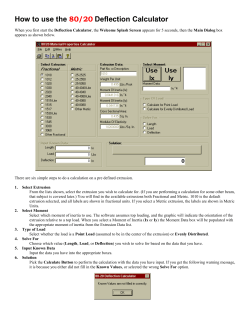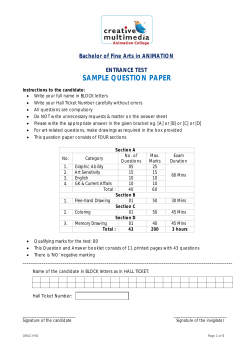
A STUDY OF DRAWING AND EXTRUSION
A STUDY OF DRAWING AND EXTRUSION PROCESSES BY RAJNISH PRAKASH Mechanical Engineering Department Submitted in fulfilment of the requirements of the degree of Doctor of Philosophy to the Indian Institute of Technology,Delhi October11975 (i) CERTIFICATE This is to certify that the Thesis entitled,BA Study of Drawing and Extrusion Processesn being submitted by Shri Rajnish Prakash to the Indian Institute of Technology, Delhi for the award of the Degree of Doctor of Philosophy in Mechanical Engineering, is a record of bonafide research work carried out by him. He has worked under my guidance and supervision and has fulfilled the requirements for the submission of this Thesis, which has reached the requisite standard. The results contained in this Thesis have not been submitted in part or in full, to any other University or Institute for the award of any degree or diploma. (B.L.Juneja) Professor, Mechanical Engineering Department, Indian Institute of Technology,Delhi ACKNOWLEDGEMENTS The author records his deep sense of gratitude to Dr.B.L.Juncja for suggesting the problem and for providing valuable and inspiring guidance. It is with his Constant encouragement that the thesis has seen this day. The author thanks the staff of Production Engineering Laboratory for their help in making the specimens for the experiment. Thanks are due to the staff of Materials Testing Laboratory, Applied Mechanics Department for their cooperation in the experimental work. The financial support for the present work was provided by the MiniStry of Education, Government of India, under the Quality Improvement Programme, to which the author was sponsored by the Aligarh Muslim University, Aligarh. This is gratefully acknowledged. In the and the author also wishes to thank Shri J.N.Saini, for his typing the manuscript with care and Shri Dilbagh for preparation of drawings. (Rajnish Prakash) ( iii) ABSTRACT Drawing and extrusion processes have assumed importance among the modern industrial manufacturing processes. Both circular and non—circular sections are drawn and extruded on commercial scale. However, duo to the complexities of metal behaviour and the friction over the tool material interfaces, only approximate analyses of drawing and extrusion procCsses have been possible. Even these solutions have been limited to round sections, and no general solution to processes involving flow through a die exists. In the present study an upper bound analysis has been constructed for polygonal sections, Also, a general upper bound solution is given for axi—symmetric contained flow processes. A constant frictional shear stress is assumed to be acting over the tool—material interface and the metal is assumed to be isotropic, rigid perfectly plastic 'obeying von Mises' yield criterion. The thesis gives the . theoretical and experimental studies carried out by the author to aid the understanding of the influence of various parameters on the process variables in drawing and extrusion. The -contents_ of the various chapters are as follows. Chapter 1 deals with general mathematical formulation of metal behaviour and interfacial friction during drawing and extrusion processes with suitable assumptions. Chapter 2 gives the analysis of flow of metal through converging polygonal dies. The original and final sections are taken to be similar. The solution gives optimum die angle, Div) dead zone and critical angles. The deformed grid patterns as may emerge on the final product surface and the central section are predicted. The analysis is extended to any polygonal section which has an inscribed circle. The analysis directly applies to wire and rod drawing. The drawing through a conical die is showA to be a special case of the above analysis. In Chapter 3 the analysis of flow through a converging polygonal die is employed to analyse direct, indirect and piercing extrusion of regular polygonal or such irregular polygonal shapcs,which have an inscribed circle. Numerical solutions are given for different conditions of the processes. Chapter 4 gives the analysis of metal flow through an axisymmetric curved die and mandrel. The solution is . moral and covers processes of tube drawing and extrusion with stationary or moving mandrel, fixed conical or curved plug. When the mandrel radius is taken as zero, th-J solution reduces to that of rod or wire drawing or extrusion. Some of the solutions obtained by various authors have been shown as special cases of this general solution. • In Chapter 5, the general solution obtained in Chapter ¢ has been extended to layered piecewise homogeneous metal tubes (composite material tubes). The analysis is applied to analyse composite rod drawing and conditions leading to proportional or cladding type deformation arc given. It is assumed generally, that the effect of friction on the change in tube-wall thickness after sinking through a conical die is of thinning. However, no experimental evidence is known to justify this assumption. Similarly it is generally accepted that the change in wall thickness after .sinking through a conical die is gradual as reduction in outside diameter increases from zero. In Chapter 6 the experiment conducted to study the effects of friction and small reductions on the change in wall thickness is described. Based on the observations of the-experiment, it is concluded that the effect of friction on the change in wall thickness is that of thickening it rather than thinning. Also for small reductions. the wall thickness is found to undergo a sudden thinning...For further increase in reduction of outside diameter,the wallthickness recovers and finally the change becomes gradual. The solution for composite rod drawing through conical die of Chapter 5 is used to give the wall thickness change after sinking through conical die, by the use of minimum energy approach [89]:fhe solution predicts the correct fronds as observed experimentally. The earlier theories do not predict correctly, the effects of friction and small reductions over change in wall thickness during sinking thyough a conical die. The thesis is concluded with scope for future work and the references consulted for the above work have been given. (vi) CONTENTS CERTIFICATE ... ... (i) ACKNOWLEDGEMENTS .0. ••• (ii) ABSTRACT ... eve (iii) COP:TENTS 060 4.0 064 000 LIST OF FIGURES SYLIBOLS ... CHAPTER 1 INTRODUCTION (viii) ... (xi ) 0 • • 1 ,.. 2 D*0 3 004 15 1.4 Heat Generation. *0* 18 1.5 Method of Analysis. 000 20 00. 21 2.1 Introduction.... 000 21 2.2 Analysis. 0.. 00. 23 2.3 The Flow of Metal. ... 46 2.4 Results and Discussion. ... 53 000 1.1 Historical Background 1.2 Mechanics of Metal Behaviour in Plastic Deformation. 1.3 Interface Friction During Plastic Working Processes. CHAPTER 2 CHAPTER (vi) 3 FLOW THROUGH POLYGONAL CONVERGING DIES EXTRUSION OF POLYGONAL SECTIONS. 3.1 Introduction 006 3.2 Anal ysis 3.3 3.4 ... 61 000 61 •• • 62 Experimentation. 00. 0.0 75 Results and Discussion. 400 82 0.0 CHAPTER 4GENERAL SOLUTION TO AXI-SYMMETRIC CONTAINED 93 FLOW PROCESSES. 000 4.1 Introduction. • .. ••• 4.2 Analysis. ••• • • • 94 4.3 Flow ThroUgh Conical Die-Special Case. 108 4.4 Discussion.• • • • . • 115 CHAPTER 5COMPOSITE TUBES AND RODS. 5.1 Introduction ... 118 000 600 ••. 5.2 Analysis. 93 118 ... 118 5.3 Composite Tube Drawing Through Conical Die and Cylindrical Mandrel. ... 130 5.4 Composite Rod Drawing Through Conical Die.• • • ... 138 ... 5.5 Discussion. ... 152 CHAPTER 6TUBE SINKING THROUGH CONICAL DIE. 600 6.1 Introduction. .•• ... 154 6.2 Experiment. 006 6.4 Comparison Between Theory and Experiments-Discussion and ConcluSions. CHAPTER 7 000 RETROSPECTION AND SCOPE 7.1 Achievements. • .• 157 ,.. 169 ••• 6.3 Analysis. 154 ,..184 ... 191 ... 191 7.2 Scope For Future Work. REFERENCES.• • • 193 ... 195 APPENDIX I YIELD STRESS IN COMPRESSION ... 207 APPENDIX II TUBE SINKING THROUGH CONICAL DIE ... 214
© Copyright 2025











